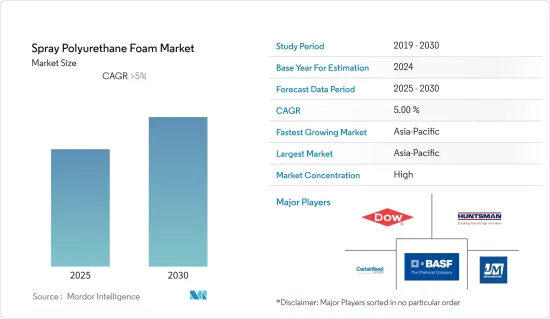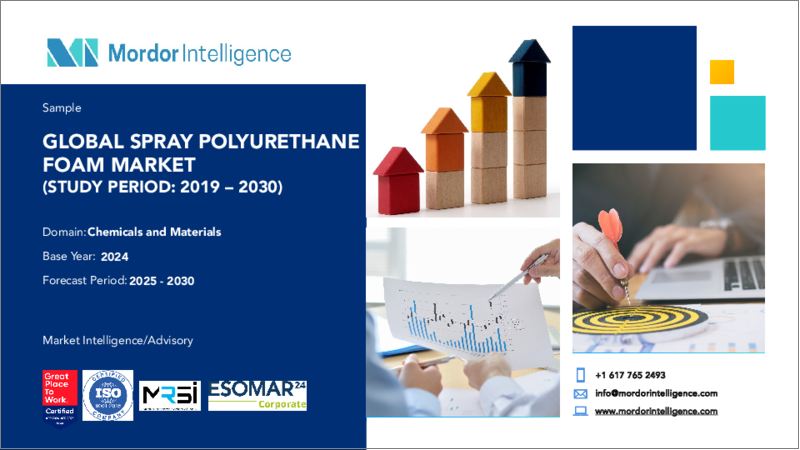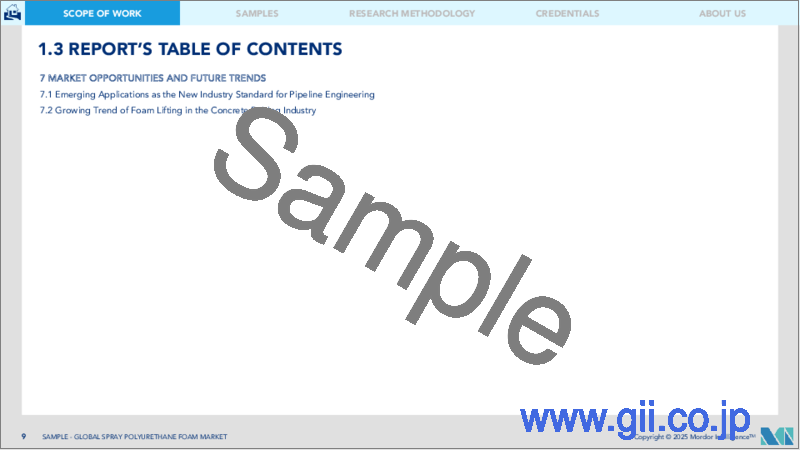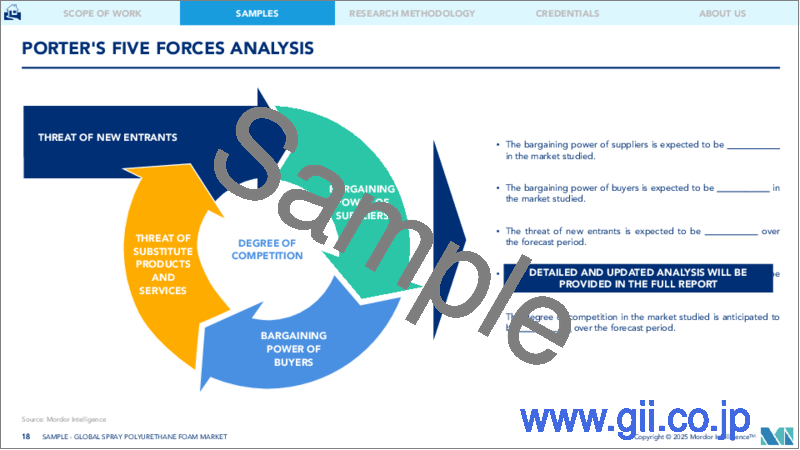|
|
市場調査レポート
商品コード
1630194
スプレーポリウレタンフォーム:市場シェア分析、産業動向と統計、成長予測(2025年~2030年)Spray Polyurethane Foam - Market Share Analysis, Industry Trends & Statistics, Growth Forecasts (2025 - 2030) |
||||||
カスタマイズ可能
適宜更新あり
|
|||||||
価格
| スプレーポリウレタンフォーム:市場シェア分析、産業動向と統計、成長予測(2025年~2030年) |
|
出版日: 2025年01月05日
発行: Mordor Intelligence
ページ情報: 英文 120 Pages
納期: 2~3営業日
|
全表示
- 概要
- 目次
概要
スプレーポリウレタンフォーム市場は予測期間中に5%以上のCAGRが見込まれています。

主なハイライト
- COVID-19はサプライチェーンと原材料の混乱を引き起こし、自動車や建設などの産業の減速につながり、そのためにスプレーポリウレタンフォームの生産は減少しました。スプレー・ポリウレタン市場は、予測期間終了時(2021年)には流行前の水準に達すると予想されます。これは景気が良くなり始め、供給状況が良くなったためです。
- 温室効果ガス排出に関する懸念の高まりと、建物の耐久性管理戦略の主要部分としての市場の大きな可能性が、短期的には市場の成長を牽引する主な要因です。
- 他方、ガラス繊維やセルロースの断熱製品が普及しつつあり、これが市場の成長を鈍化させる可能性が高いです。
- 今後数年間は、コンクリートかさ上げ事業でフォームリフティングが普及しつつあるため、市場が儲けるチャンスは増えると思われます。
- スプレーポリウレタンフォーム(SPF)材料の消費では、アジア太平洋が大きなシェアを占めています。この地域はまた、エネルギー効率の高い建設とアスベスト封じ込め用途の増加によって、予測期間中に最も速い成長を示すことが期待されています。
スプレーポリウレタンフォームの市場動向
断熱用途での使用の増加
- スプレーポリウレタンフォームは断熱材用途に使用されており、その消費量は時間の経過とともに着実に増加しています。しかし、スプレーポリウレタンフォーム断熱材は過去10年間に急激な成長を遂げました。
- Energy Saving Trustの計算によると、住宅の熱損失の25%は屋根から、35%は壁から、25%は窓や隙間風から、15%は床からです。したがって、空洞の壁とロフトまたは屋根の断熱は、誰もが設置できる最も効果的なエネルギー効率化対策の2つです。
- 壁、天井、床、屋根裏、天井裏、屋根裏部屋、屋根などの建物外壁にスプレーポリウレタンフォームが広く使用されているのは、エネルギー効率の改善、特に建物の空気漏れを減らすための法規制に直接関係しています。
- アジア太平洋地域では、主要経済圏の人口増加と急速な都市化により、住宅建設需要が増加しています。Global Construction Perspectivesとオックスフォード・エコノミクスの調査によると、インドでは今後14年間、住宅需要の増加に対応するため、毎日3万1,000戸の住宅を建設する必要があります。2030年末までには、1億7,000万戸の住宅が建設されることになります。
- カリフォルニア州のTitle 24や国際基準審議会のInternational Energy Conservation Codeのように、ますます厳しくなる建築基準法によって、建設業者は化石燃料の使用量が少なく、エネルギーを節約できる材料を使用することを余儀なくされています。
- さらに、ハーバード大学住宅研究共同センターによると、アメリカ人だけでも住宅の改築や修繕に年間4,000億米ドル以上を費やしており、その中には断熱材の使用も含まれている可能性があり、その結果需要が増加しています。
- Eurostatが発表したデータによると、2021年の建築収入は大幅に増加しました。
- これらのことから、断熱材にSPFを使用することで、今後数年間でスプレーポリウレタンフォームの市場が拡大する可能性が高いです。
市場を独占するアジア太平洋地域
- アジア太平洋地域が予測期間中最大の市場になると予想されるのは、政府が同地域の建設とコーティング産業により多くの支出を行っているからです。
- 中国はアジア太平洋地域でGDPが最大の経済大国です。同国の成長率は依然として高いが、徐々に低下しており、経済は投資から消費へ、製造業からサービス業へ、外需から内需へとリバランスしつつあります。
- 中国の第14次5ヵ年計画によると、都市部の定住者数は2025年までに65%まで増加することになっています。これにより、今後数年間は調査対象市場に対する需要が高まると予想されます。
- 中国がパンデミックから回復するにつれ、多くの住宅建設プロジェクトが始まった。香港の住宅当局は、2030年までの10年間で30万1,000戸の公共住宅を供給することを目指しています。
- Atma Nirbhar Bharat」や「Make in India」などのイニシアチブは自動車産業を押し上げると予想されるため、今後数年間はスプレーポリウレタンフォームの需要にプラスの影響を与えると思われます。
- NAP 2021の下、マレーシアの自動車製造業は2030年までに年間147万台の自動車を生産すると予想されています。現在から2030年まで、同国の自動車製造に使用されるスプレーポリウレタンフォームの需要が増加すると予想されます。
- 以上のような要因から、予測期間中、アジア太平洋地域がスプレーポリウレタンフォーム市場を独占すると予想されます。
その他の特典:
- エクセル形式の市場予測(ME)シート
- 3ヶ月間のアナリスト・サポート
目次
第1章 イントロダクション
- 調査の前提条件
- 調査範囲
第2章 調査手法
第3章 エグゼクティブサマリー
第4章 市場力学
- 促進要因
- 温室効果ガス排出に関する懸念の高まり
- 建物の耐久性管理戦略の主要コンポーネントとしての強い可能性
- 冷蔵スペース、ウォークイン冷蔵庫、パイプ、タンクなどの産業用断熱材における重要性の高まり
- 抑制要因
- ガラス繊維やセルロース断熱ソリューションとの競合激化
- 厳しい環境保護庁(EPA)と労働安全衛生局(OSHA)の規制
- 業界バリューチェーン分析
- ポーターのファイブフォース分析
- 供給企業の交渉力
- 消費者の交渉力
- 新規参入業者の脅威
- 代替品の脅威
- 競合の程度
第5章 市場セグメンテーション(金額ベース市場規模)
- 製品タイプ別
- 二液型高圧スプレーフォーム
- 二液型低圧スプレーフォーム
- 一液型フォーム(OCF)
- その他の製品タイプ
- 用途別
- 断熱
- 防水
- アスベスト封止
- シーラント
- その他の用途
- 地域別
- アジア太平洋
- 中国
- インド
- 日本
- 韓国
- その他アジア太平洋地域
- 北米
- 米国
- カナダ
- メキシコ
- 欧州
- ドイツ
- 英国
- イタリア
- フランス
- その他欧州
- 南米
- ブラジル
- アルゼンチン
- その他南米
- 中東・アフリカ
- サウジアラビア
- 南アフリカ
- その他中東とアフリカ
- アジア太平洋
第6章 競合情勢
- M&A、合弁事業、提携、協定
- 市場シェア(%)**/ランキング分析
- 主要企業の戦略
- 企業プロファイル
- ACCELLA CORPORATION
- BASF SE
- CERTAINTEED
- Dow
- Huntsman International LLC
- Icynene-Lapolla
- INVISTA
- ISOTHANE LTD.
- Johns Manville
- NCFI Polyurethanes
- SOPREMA
- Specialty Products Inc.
第7章 市場機会と今後の動向
- パイプラインエンジニアリングの新たな業界標準となるアプリケーションの出現
- 嵩コンクリート業界におけるフォームリフティングの動向拡大
目次
Product Code: 61474
The Spray Polyurethane Foam Market is expected to register a CAGR of greater than 5% during the forecast period.

Key Highlights
- COVID-19 caused disruption in the supply chain and raw materials, leading to a slowdown in industries like automotive and construction, owing to which the production of spray polyurethane foams decreased. The spray polyurethane market is expected to reach its pre-pandemic level by the end of the forecast period, which is 2021. This is because the economy started to get better and the supply situation got better.
- Growing concerns about greenhouse gas emissions and the market's strong potential as a key part of a building's durability management strategy are the main things that will drive the market's growth in the short term.
- On the other hand, fiberglass and cellulose insulation products are becoming more popular, which will likely slow the growth of the market.
- In the next few years, the market is likely to have more chances to make money because foam lifting is becoming more popular in the concrete raising business.
- Asia-Pacific holds a significant share in the consumption of spray polyurethane foam (SPF) materials. The region is also expected to witness the fastest growth during the forecast period, powered by the increase in energy-efficient construction and asbestos encapsulation applications.
Spray Polyurethane Foam Market Trends
Increasing Usage in the Insulation Applications
- Spray polyurethane foam has been used in insulation applications, and its consumption has steadily grown over time. However, spray polyurethane foam insulation has experienced exponential growth during the past decade.
- The Energy Saving Trust calculates that 25% of heat loss in homes is through the roof, 35% is through the walls, 25% is through windows or draughts, and 15% is through the floor. Hence, cavity walls and loft or roof insulation are two of the most effective energy efficiency measures anyone may install.
- The widespread use of spray polyurethane foam in building envelope assemblies, including walls, ceilings, floors, attics, crawl spaces, and roofing, is linked directly to code-mandated improvements in energy efficiency and, specifically, requirements for reducing building air leakage.
- Across the Asia-Pacific region, demand for residential construction has been rising owing to the growing population and rapid urbanization across major economies. According to a study done by Global Construction Perspectives and Oxford Economics, India will need to build 31,000 homes every day for the next 14 years to keep up with the growing demand for housing in the country. By the end of 2030, this will add up to 170 million homes.
- More and more strict building codes, like Title 24 in California and the International Energy Conservation Code from the International Code Council, force builders to use materials that use less fossil fuel and save energy.
- Furthermore, according to the Harvard Joint Center for Housing Studies, Americans alone spend more than USD 400 billion per year on residential renovations and repairs, which may include the use of insulation, which in turn increases their demand.
- The demand for building insulation is expected to rise in Germany as residential construction expands.As per data published by Eurostat, building construction revenue increased significantly in 2021.
- Because of all of these things, the use of SPF for insulation is likely to grow the market for spray polyurethane foam over the next few years.
Asia-Pacific Region to Dominate the Market
- Asia-Pacific is expected to be the largest market during the forecast period because the government is spending more on the construction and coating industries there.
- China is the largest economy in the Asia-Pacific region in terms of GDP. The growth rate in the country remains high but is gradually diminishing, and the economy is rebalancing from investment to consumption, manufacturing to services, and external to internal demand.
- According to China's 14th five-year plan, the number of permanent urban residents is supposed to rise to 65% by 2025. This is expected to increase demand for the market studied in the years to come.
- As China recovered from the pandemic, many residential construction projects kicked off in the country. Hong Kong's housing authorities launched a number of initiatives to jumpstart the construction of low-cost housing.The officials aim to provide 301,000 public housing units in 10 years, until 2030.
- Government reforms aided significant growth in industrial production as well as end-user demand for automobiles in India.Initiatives, such as "Atma Nirbhar Bharat" and "Make in India," are expected to boost the automotive industry, thereby positively impacting the demand for spray polyurethane foams in the coming years.
- Under the NAP 2021, the automotive manufacturing industry in Malaysia is expected to produce 1.47 million vehicles annually by 2030. From now until 2030, this is expected to increase the demand for spray polyurethane foam used to make cars in the country.
- Owing to all the aforementioned factors, the Asia-Pacific region is expected to dominate the spray polyurethane foam market during the forecast period.
Spray Polyurethane Foam Industry Overview
The spray polyurethane foam market is consolidated by nature. Some of the major players in the market include (in no particular order) BASF SE, Huntsman International LLC, Johns Manville, Dow, and CERTAINTED, among others.
Additional Benefits:
- The market estimate (ME) sheet in Excel format
- 3 months of analyst support
TABLE OF CONTENTS
1 INTRODUCTION
- 1.1 Study Assumptions
- 1.2 Scope of the Study
2 RESEARCH METHODOLOGY
3 EXECUTIVE SUMMARY
4 MARKET DYNAMICS
- 4.1 Drivers
- 4.1.1 Growing Concerns Related to Greenhouse Gas Emissions
- 4.1.2 Strong Potential as a Key Component of the Durability Management Strategy for a Building
- 4.1.3 Growing Significance in Industrial Insulation for Cold Storage Spaces, Walk-in Refrigerators, Pipes, Tanks, and Others
- 4.2 Restraints
- 4.2.1 Growing Competition from Fiberglass and Cellulose Insulation Solutions
- 4.2.2 Stringent Environmental Protection Agency (EPA) and Occupational Safety and Health Administration (OSHA) Regulations
- 4.3 Industry Value-Chain Analysis
- 4.4 Porter's Five Forces Analysis
- 4.4.1 Bargaining Power of Suppliers
- 4.4.2 Bargaining Power of Consumers
- 4.4.3 Threat of New Entrants
- 4.4.4 Threat of Substitute Products and Services
- 4.4.5 Degree of Competition
5 MARKET SEGMENTATION (Market Size in Value)
- 5.1 Product Type
- 5.1.1 Two-component High-Pressure Spray Foam
- 5.1.2 Two-component Low-Pressure Spray Foam
- 5.1.3 One Component Foam (OCF)
- 5.1.4 Other Product Types
- 5.2 Application
- 5.2.1 Insulation
- 5.2.2 Waterproofing
- 5.2.3 Asbestos Encapsulation
- 5.2.4 Sealant
- 5.2.5 Other Applications
- 5.3 Geography
- 5.3.1 Asia-Pacific
- 5.3.1.1 China
- 5.3.1.2 India
- 5.3.1.3 Japan
- 5.3.1.4 South Korea
- 5.3.1.5 Rest of Asia-Pacific
- 5.3.2 North America
- 5.3.2.1 United States
- 5.3.2.2 Canada
- 5.3.2.3 Mexico
- 5.3.3 Europe
- 5.3.3.1 Germany
- 5.3.3.2 United Kingdom
- 5.3.3.3 Italy
- 5.3.3.4 France
- 5.3.3.5 Rest of Europe
- 5.3.4 South America
- 5.3.4.1 Brazil
- 5.3.4.2 Argentina
- 5.3.4.3 Rest of South America
- 5.3.5 Middle-East and Africa
- 5.3.5.1 Saudi Arabia
- 5.3.5.2 South Africa
- 5.3.5.3 Rest of Middle-East and Africa
- 5.3.1 Asia-Pacific
6 COMPETITIVE LANDSCAPE
- 6.1 Mergers and Acquisitions, Joint Ventures, Collaborations, and Agreements
- 6.2 Market Share (%)**/ Ranking Analysis
- 6.3 Strategies Adopted by Leading Players
- 6.4 Company Profiles
- 6.4.1 ACCELLA CORPORATION
- 6.4.2 BASF SE
- 6.4.3 CERTAINTEED
- 6.4.4 Dow
- 6.4.5 Huntsman International LLC
- 6.4.6 Icynene-Lapolla
- 6.4.7 INVISTA
- 6.4.8 ISOTHANE LTD.
- 6.4.9 Johns Manville
- 6.4.10 NCFI Polyurethanes
- 6.4.11 SOPREMA
- 6.4.12 Specialty Products Inc.
7 MARKET OPPORTUNITIES AND FUTURE TRENDS
- 7.1 Emerging Applications as the New Industry Standard for Pipeline Engineering
- 7.2 Growing Trend of Foam Lifting in the Concrete Raising Industry






